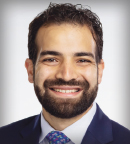Imagine walking into a fancy restaurant only to find a menu consisting mostly of kids’ dishes. It would make no sense. Just 25% of restaurant diners are younger than age 12, and they rarely write Yelp reviews.
But when it comes to cancer treatment, this is not very far from what we do. The median age for a new cancer diagnosis is 67,1 and among those who die of cancer each year, 73% are older adults. Yet just one in four clinical trial participants is aged 70 or older.2 Consequently, guidelines for most new cancer therapies are based on a median age that is significantly younger than the patient population who actually receives these therapies.
That’s quite a conundrum. More than half of patients older than age 65 experience toxicity of grade 3 or worse while undergoing standard chemotherapy.3
The side effects are often worse with newer drugs released under the accelerated approvals process of the U.S. Food and Drug Administration (FDA), whose standard doses may often be toxic for even younger patients.4 Overtreatment of older adults can diminish quality of life without providing any meaningful improvement in survival, and it can even produce complications that may lead to higher mortality.

Ramy Sedhom, MD

Bobby Green, MD

Julia Frydman, MD, MS
How can we improve geriatric oncology treatment?
In a perfect world, the toxicity problem would be redressed at its foundation, by including a correct proportion of older adults in clinical trials. This would not only help optimize treatment according to age, it might also enable physicians to better advise older patients of the impact of treatment on cognition, mobility, and other concerns. Unfortunately, it’s not that simple. Older patients are more likely to have comorbidities, transportation barriers, limited mobility, cognitive impairments, and other circumstances that make their participation in clinical trials impractical or render them outright ineligible. And, ironically, the higher likelihood of toxicity in the geriatric population makes many physicians less inclined to recommend them for clinical trials in the first place. It’s a real catch-22.
Commonsense Interventions for Older Patients
However, insufficient data on geriatric patients doesn’t mean we can ignore the issue. How can we ensure that treatment of older adults is neither too much, nor too little, with respect to medical outcome, quality of life, and patient goals? Fortunately, oncologists do have several “commonsense interventions’” at their disposal to optimize cancer care for older patients:
Whole-Patient Assessment—In the absence of clear data guiding treatment for older patients with cancer, it is essential that we assess patients’ physical condition as well as cognitive function, social support, and home environment before addressing treatment. Relatively fit older adults may have 15, 20, or more years to live, and many are able to tolerate standard treatment well. Others may be at high risk of experiencing toxicity or other negative effects from aggressive therapy, and we must take that into account when determining their treatment plans.
Patient frailty tests take as little as 10 to 15 minutes to conduct, and they can make a significant difference in treatment decisions. More in-depth geriatric assessments are relatively complicated and time-intensive, but they offer far more insight into appropriate interventions for older patients. According to the Gap 70 study,5 a 5-year research study focused on geriatric patients from 40 nonacademic oncology centers, such assessment and intervention result in 30% fewer instances of toxicity and half the number of falls when compared with a control group receiving usual care.
Proactive Monitoring—Assessments help us understand the degree of fitness or frailty expressed by a given patient at a point in time, but they are not dynamic, and we know that older adults’ conditions can deteriorate rapidly without warning. Thus, it makes sense to continuously reassess patient function and tolerability to treatment. Nurse navigation support or electronic self-reporting monitoring allows oncology teams to understand how patients are tolerating treatment and enables proactive changes to be made before toxicity or other adverse effects take hold. We can ask the following questions: “Is Mrs. Smith declining more than we would expect from another patient?” “Do we need to hold therapy? Change therapy? Increase monitoring? Increase support?” According to a 2017 study,6 proactive monitoring, and the rapid response to adverse events it enables, improved median overall survival by more than 5 months.
Patient frailty tests take as little as 10 to 15 minutes to conduct, and they can make a significant difference in treatment decisions.— Ramy Sedhom, MD; Bobby Green, MD; and Julia Frydman, MD, MS
Tweet this quote
Dose Adjustment—For patients who are identified as high risk on assessments or other predictors of toxicity,7 attempting to optimize dosage or frequency to a patient’s tolerance, rather than following standard recommendations, may be wise. Although there are few data to guide optimal adjustments, research suggests that reducing the chemotherapy dosage by 15% to 20% can result in greater tolerability among older adults. Data from the Gap 70 study,8 for example, revealed a 15% reduced risk of serious toxicity and a 20% reduced risk of functional decline, without compromising the efficacy of treatment. In at least one more study,9 reducing the chemotherapy dosage to 80% or less of the protocol dose for elderly patients even correlated with a median survival rate increase of 15%. Finally, in a study of patients with advanced gastroesophageal cancer,10 those who received 60% of the standard intensity of treatment dose experienced greater overall treatment utility, combining clinical efficacy, tolerability, and patient-assessed treatment value, than those who received higher doses. This was true even among younger and less frail patients.
Palliative Care—For a 40-year-old mother of two young children, the goal of cancer treatment is usually clear: complete remission and long-term survival. But when you ask older patients with cancer about their priorities, a majority regard symptom control, emotional coping, and other quality-of-life measures at least as much as longevity and sometimes more.11
We really need to ask the following questions: “What’s the trade-off?” “How can we best align care with the patient’s personal goals?” I (JF) had one frail patient with pancreatic cancer, for instance, for whom “staying out of the hospital” and “spending quality time with his grandchildren” were the most important things to him. Avoidance of toxicity was so paramount to him that he was considering undergoing no treatment whatsoever. Instead, in collaboration with his oncologist, he decided on a low dose of chemotherapy on an altered schedule, which helped slow down his disease progression without producing excessive side effects. Once his condition advanced, he chose to receive no further chemotherapy and transitioned to hospice care.
It’s Time to Change Our Approach
Although commonsense interventions are useful for oncologists to consider when treating older patients with cancer, this cannot be our end game. There remains an urgent need to make equitable cancer care for older adults a priority.
Guidelines for most new cancer therapies are based on a median age that is significantly younger than the patient population who actually receives these therapies.— Ramy Sedhom, MD; Bobby Green, MD; and Julia Frydman, MD, MS
Tweet this quote
For starters, we can follow ASCO’s five recommendations to improve age-accurate evidence in clinical trials.12 We also need to make it easier for oncologists to assess patient frailty and monitor at-risk patients on a proactive basis—either directly, if they are able to dedicate staff resources to executing these measures, or else through competent third-party care navigators. A full geriatric assessment, for instance, can take well over 60 minutes, but even devoting 10 to 15 minutes to do a patient frailty assessment can be challenging for many busy practices. Hence, we also need to work out how to reimburse doctors for taking these potentially life-saving measures as a standard operating practice. Finally, we need to normalize the practices of dose optimization, outcome prioritization, and early engagement with palliative care, to help ensure the treatments we administer are aligned with what’s truly best for geriatric patients, in their own eyes.
As doctors, we are sworn to offer the best possible care we can to all our patients. And, as cancer care specialists treating older adults, we must ensure this care is not too much nor too little but personalized care that is just right.
Dr. Sedhom is a medical oncologist and palliative care physician at Penn Medicine. Dr. Green is Chief Medical Officer at Thyme Care, a value-based cancer care company. Dr. Frydman is Medical Director for Palliative Care at Thyme Care.
Disclaimer: This commentary represents the views of the author and may not necessarily reflect the views of ASCO or The ASCO Post.
DISCLOSURE: Dr. Sedhom and Dr. Frydman reported no conflicts of interest. Dr. Green is a shareholder of Thyme Care.
REFERENCES
1. National Cancer Institute: Surveillance, Epidemiology, and End Results Program: Cancer Stat Facts: Cancer of Any Site. Available at https://seer.cancer.gov/statfacts/html/all.html. Accessed August 14, 2024.
2. Singh H, Kanapuru B, Smith C, et al: FDA analysis of enrollment of older adults in clinical trials for cancer drug registration: A 10-year experience by the U.S. Food and Drug Administration. 2017 ASCO Annual Meeting. Abstract 10009.
3. Ostwal V, Ramaswamy A, Bhargava P, et al: Cancer Aging Research Group (CARG) score in older adults undergoing curative intent chemotherapy: A prospective cohort study. BMJ 11:e047376, 2021.
4. Chemo can be brutal: This FDA effort aims to make it less so. The Washington Post, May 4, 2024. Available at https://www.washingtonpost.com/health/2024/05/04/cancer-chemo-drug-dosage-fda/. Accessed August 14, 2024.
5. Mohile SG, Mohamed MR, Xu H, et al: Evaluation of geriatric assessment and management on the toxic effects of cancer treatment (GAP70+): A cluster-randomised study. Lancet 398:1894-1904, 2021.
6. Basch E, Deal AM, Dueck AC, et al: Overall survival results of a trial assessing patient-reported outcomes for symptom monitoring during routine cancer treatment. JAMA 318:197-198, 2017.
7. Feliu J, Custodio AB, Pinto-Marin A, et al: Predicting risk of severe toxicity and early death in older adult patients treated with chemotherapy. Cancers 15:4670, 2023.
8. Mohamed MR, Rich DQ, Seplaki C, et al: Primary treatment modification and treatment tolerability among older chemotherapy recipients with advanced cancer. JAMA Netw Open 7:e2356106, 2024.
9. Munker S, Gerken M, Fest P, et al: Chemotherapy for metastatic colon cancer: No effect on survival when the dose is reduced due to side effects. BMC Cancer 18:455, 2018.
10. Hall PS, Swinson D, Waters JS, et al: Optimizing chemotherapy for frail and elderly patients with advanced gastroesophageal cancer: The GO2 phase III trial. 2019 ASCO Annual Meeting. Abstract 4006.
11. Soto-Perez-de-Celis E, Dale W, Katheria V, et al: Outcome prioritization and preferences among older adults with cancer starting chemotherapy in a randomized clinical trial. Cancer 130:3000-3010, 2024.
12. Hurria A, Levit LA, Dale W, et al: Improving the evidence base for treating older adults with cancer: American Society of Clinical Oncology statement. J Clin Oncol 33:3826-3833, 2015.

